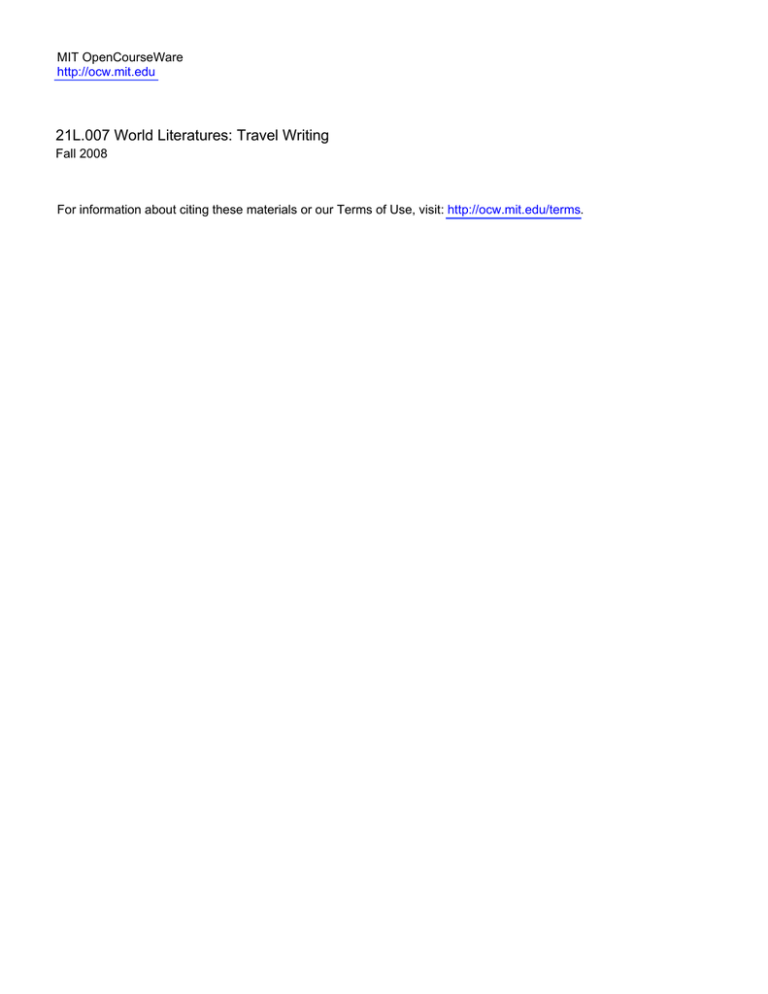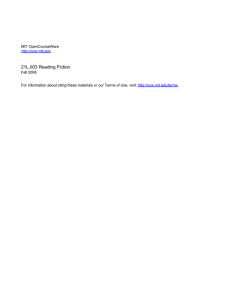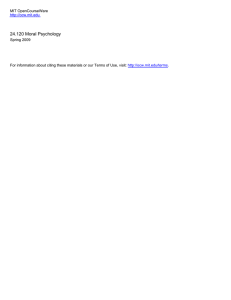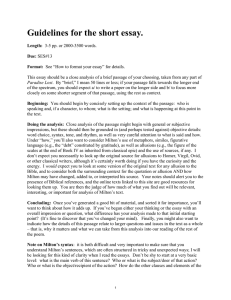21L.007 World Literatures: Travel Writing MIT OpenCourseWare .
advertisement

MIT OpenCourseWare http://ocw.mit.edu 21L.007 World Literatures: Travel Writing Fall 2008 For information about citing these materials or our Terms of Use, visit: http://ocw.mit.edu/terms. This assignment is the first stage in preparing your first essay. In your draft, I'd like you to focus on choosing and closely analyzing a passage of about 1-2 pages; you will probably also be thinking about the larger issues that connect it to the rest of the book, but try to do as much closely focused analysis as you can. For more information and suggestions, see three documents under Readings and Resources>Assignments: Close Analysis Sample, Guide to Close Reading, General Paper-Writing Guidelines. Format: Times Roman 12 pt (or similar font), double-spaced, 1" margins. See "Close Analysis Sample" for examples of how to format short and long quotations. Essay 1: on Blue Highways. Draft (3 pp.) due: 1 day after SES #7. One peer response to another draft due: SES #8. This assignment in brief: write a closely focused, analytic essay on William Least HeatMoon’s Blue Highways. I’ve described the work in steps. 1. Select and describe a passage. Begin by choosing a manageable portion of the text, ideally one that attracts, puzzles, or otherwise interests you (try to avoid ones we’ve spent a long time on in class, unless it’s a passage you yourself presented). Some sections are short enough to use in their entirety, like chapter 1 section 2; for longer sections, try to focus more tightly on an event, a conversation, a scene, or place. The piece of text you select should be no longer than a page or two. The essay should begin by describing, in a sentence or two, what happens in this piece of the text, answering the usual orienting questions of who, what, when (on the journey, in relation to other events), and where. "Why" will come later. 2. Do a close reading of this passage. What is close reading? Broadly speaking, using attention to the details of the text to generate an account of what it means and does: the contents of this particular passage, the form given to those contents by the writer, and the implications or effects that result. a. Begin by taking notes; I like to make a Xerox of the text I'm thinking about, so I can carry it around with me and mark it up. Underline, circle, draw arrows, scribble in the margins, and when you start to think of longer, more connected things to say, write those down. I’ll make some suggestions on things to notice and look for in the forthcoming “Close Reading” document, but we have of course been doing some of this in class. b. As your notes build up, start to look for patterns in your material, and think about how to organize these observations in a logically connected way that makes those patterns evident and meaningful. c. Write up your analysis as a connected piece of prose. When you write up your analysis or close reading, you are taking your reader on a tour of the text that points out and makes sense of its important features, both those that are obvious, and those that are not immediately apparent. Once you have done that, begin to think about "why" – what features of this passage (writing strategies, pre-occupying topics or questions, etc.) link it to other parts of the book. 3. Set this passage and its concerns in the larger context of the book. Why does this scene matter to the work? Why was it included, and told the way it was, noticing the things it notices? What preoccupations connect it to the larger flow of the journey and the book; what does this passage have to say about those larger concerns? In your draft, you should have gotten to about the end of step 2, with some ideas about step 3. As you go from draft to final version, you should think more about the last set of questions in step 3, and about how to integrate them with your close reading. A good analytic essay moves back and forth between details and the big picture. To that end, quote the text liberally but in a highly targeted way -- it's better to quote the exact word, phrase, or sentence you need than to gesture towards a paragraph-length block of text. Finally, find a title for the final version that sums up what’s interesting about your passage. “A discussion of Blue Highways” is not a real title. More specific (and interesting): “An Imagineer talks about work”; “Lifting salad plates: the work of an ‘imagineer’”; “What’s your line?: talk about work in the home of KFC”; you get the idea. Related documents: see Readings and Resources>Assignments for a sample close analysis (with examples of how to use quotation), a guide to close reading, and general guidelines for writing papers about literature.







